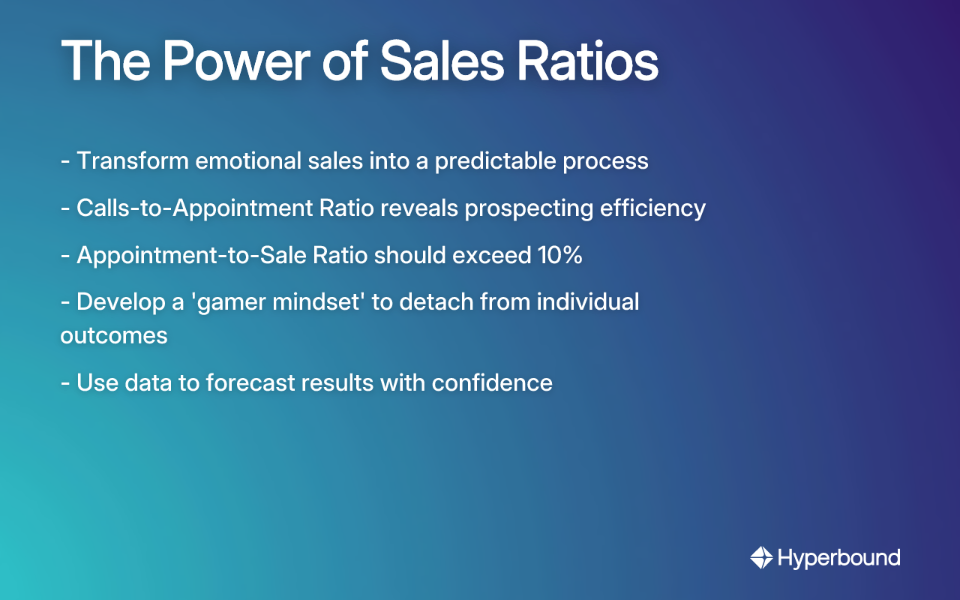
You're reviewing your CRM, your heart racing with anxiety. That big deal you've been working on for months - the one that would put you over quota - is still stuck in "Proposal Sent" status. You've sent three follow-up emails and left two voicemails this week. Your sales manager keeps asking for updates, and you can feel that dreaded "commission breath" creeping into your interactions with the prospect.
Sound familiar?
Many sales professionals struggle with the emotional rollercoaster of sales. One moment you're riding high on a closed deal, the next you're questioning your entire career path after a string of rejections. The standard advice? "Just detach from the outcome."
It's easier said than done.
After doing 40-60 dials a day for months on end, constantly facing rejection while trying to meet aggressive sales goals, burnout is real. And let's be honest - telling a sales rep to "not care about the outcome" is like telling a fish not to care about water.
But here's the reality: true detachment isn't about not caring. It's about shifting your focus from individual outcomes to a predictable, mathematical process. The secret weapon? Tracking specific sales ratios that transform your approach from emotional to analytical.
Beyond Win Rate: Your Two Foundational Sales Ratios
Most reps know their win rate (deals closed divided by total opportunities), but this is a lagging indicator that only tells you what already happened. To truly improve your performance and achieve emotional detachment, you need to master the leading indicators that drive success.
Ratio 1: Calls-to-Appointment Ratio
This ratio measures how many calls it takes to secure a qualified appointment. It answers the fundamental question: "How much activity does it take to get my foot in the door?"
Formula: Total Calls ÷ Total Appointments Booked
For example, if you make 100 calls and book 5 appointments, your ratio is 20:1.
Why it matters: A high ratio indicates inefficiency in your outreach strategy. Your messaging, targeting, or call approach may need refinement. A lower, healthier ratio means your prospecting efforts are working effectively.
Ratio 2: Appointment-to-Sale Ratio
This is arguably the most important metric for an individual rep. It measures how effectively you convert qualified conversations into closed business.
Formula: Total Appointments Held ÷ Total Sales Closed
For example, if you conduct 10 qualified appointments and close 2 deals, your ratio is 5:1.
The critical benchmark: According to sales performance data, this ratio should never drop below 10%. If you're closing fewer than 1 in 10 appointments, there's a significant issue in your sales process, value communication, or qualification approach.
What counts as an appointment? For accurate tracking, define a qualified appointment as a meeting that:
- Lasts at least 15 minutes
- Includes a discussion about pricing or budget
- Involves a decision-maker
This ensures you're measuring the conversion of genuinely qualified prospects rather than casual conversations.
The Psychological Payoff: Adopting a "Gamer Mindset" for Sales
Once you know your personal ratios (e.g., it takes 50 calls to get 5 appointments, and 5 appointments to get 1 sale), everything changes. Each individual call no longer carries the weight of potential failure - it becomes just one action in a predictable numbers game.
Think of it like adopting a "gamer mindset" for sales. In video games, you don't expect to win every battle. You expect to gain experience points, learn the mechanics, and gradually level up. Similarly, in sales:
- Each dial isn't a potential rejection; it's one step closer to your statistical appointment
- Each appointment isn't make-or-break; it's part of your conversion ratio
- Each "no" isn't a personal failure; it's data that helps you refine your approach
When a prospect doesn't commit, it no longer ruins your day - it's simply an expected part of your ratio. You know exactly how many more calls you need to make to hit your targets.
This data-driven approach eliminates "mind deals" (those opportunities you irrationally pin your hopes on) and builds unshakable confidence. When your sales manager asks about your pipeline, you can say: "I made 200 calls this month, resulting in 20 appointments. Based on my 10% appointment-to-sale ratio, I expect to close 2 deals from this activity."
No more emotional attachment to individual outcomes. Just mathematical certainty.

Level Up Your Metrics: Calculating Pipeline Velocity
Once you've mastered the foundational ratios, it's time to understand pipeline velocity - a comprehensive "health score" for your entire sales funnel that measures how quickly you're generating revenue.
Formula: Pipeline Velocity = (Number of Opportunities × Average Deal Size × Win Rate) ÷ Length of Sales Cycle
Let's break down each component:
- Number of Opportunities: How many qualified deals are in your pipeline? This reflects your ability to consistently "keep the hopper full" through prospecting activities.
- Average Deal Size: What's the typical value of your closed deals? Calculate this by dividing total revenue by number of closed deals.
- Win Rate: What percentage of opportunities do you close? Formula: Closed Deals ÷ Total Opportunities.
- Length of Sales Cycle (in days): How long does it take from first contact to close?
For example, if you have:
- 10 opportunities in your pipeline
- $5,000 average deal size
- 25% win rate
- 30-day sales cycle
Your pipeline velocity would be: (10 × $5,000 × 0.25) ÷ 30 = $416.67 per day
This formula reveals the four critical levers you can pull to increase revenue:
- Generate more opportunities
- Increase your average deal size
- Improve your win rate
- Shorten your sales cycle
The beauty of this metric is that it helps you make strategic decisions about where to focus your improvement efforts.

Building Your Data-Driven System: Activity Tracking Fundamentals
To calculate your ratios accurately, you need clean, consistent data. Focus on tracking these critical leading indicators:
- Call Volume: Total dials made (including cold calling attempts)
- Email Outreach: Number of prospecting emails sent
- Social Touches: LinkedIn messages, comments, and other social engagements
- Total Touchpoints: Combined outreach activities across all channels
- Appointments Set: Qualified meetings scheduled
- Appointments Held: Qualified meetings that actually occurred
- Sales Closed: Deals successfully completed
Industry benchmarks can provide valuable perspective:
- The average closing rate across industries is around 20%, while high-performing organizations achieve 30%
- Software companies average a 22% close rate, financial services 19%, and biotech 15%
- Selling to existing customers has a 60-70% close rate, versus only 5-20% for new prospects
For effective tracking and improvement, consider these tools:
- AI Coaching Platforms like Hyperbound: Go beyond tracking activity to analyze what actually works in your sales calls. These platforms provide objective feedback on performance, helping you improve the ratios themselves.
- Your CRM system (Salesforce, HubSpot, etc.): Use this as the foundation where all activity data lives.
- A simple spreadsheet dashboard: This can help you monitor your 3-4 key metrics in real-time.

Actionable Template for Tracking Your Sales Ratios
Here's a simple weekly tracking template you can implement immediately:
Week ofTotal CallsEmails SentAppointments SetAppointments HeldSales ClosedCalls-to-Appointment RatioAppointment-to-Sale RatioNotes & InsightsMay 11257586115.66.0New script improved appointment rateMay 81106065118.35.0Focused more on friends-of-a-friend referrals
Instructions:
- Commit to filling this out at the end of every week for one month
- Calculate your ratios using the formulas provided
- After 4 weeks, determine your monthly average for each ratio - this is your personal baseline
- Use this baseline to set activity goals - if you need to close 2 deals next month and your appointment-to-sale ratio is 10%, you know you need to hold at least 20 qualified appointments
Becoming a Sales Scientist
By tracking these ratios, you transform from an emotional, outcome-focused rep to a strategic, process-driven "sales scientist." This approach doesn't just improve your numbers - it fundamentally changes your experience of the job:
- Less Stress: When you know exactly how many calls it takes to hit your quota, rejection becomes an expected part of the process, not a personal failure
- Greater Control: You focus on the activities you can control (calls made, emails sent) rather than outcomes you can't (a prospect's final decision)
- Improved Coaching: Specific ratio analysis helps identify exactly where in your sales process you need improvement
- Eliminated "Salesiness": When you're detached from individual outcomes, that desperate "commission breath" disappears from your interactions
Remember that detachment isn't about not caring about results - it's about trusting the process. When you approach sales as a mathematical equation rather than an emotional endeavor, you'll find that paradoxically, your results improve precisely because you're less attached to them.
Start today by picking one ratio - like Calls-to-Appointment - and tracking it for two weeks. The clarity you gain will be the first step toward transforming your entire sales approach from an anxiety-producing guessing game to a predictable, data-driven process.
Your quota doesn't care about your feelings; it only cares about your numbers. So focus on the numbers, and let the feelings take care of themselves.
Frequently Asked Questions
What are the most important sales ratios for a rep to track?
The two most important foundational sales ratios for an individual rep are the Calls-to-Appointment Ratio and the Appointment-to-Sale Ratio. The first measures your prospecting efficiency (how many calls it takes to get a meeting), while the second measures your closing effectiveness (how many meetings it takes to get a sale). Mastering these provides a clear, mathematical view of your performance.
How can tracking numbers help with sales burnout and rejection?
Tracking sales ratios helps combat burnout by reframing rejection from a personal failure into a predictable part of a process. Instead of feeling defeated by a "no," you see it as a necessary data point on the path to your next "yes." This shifts your focus from uncontrollable outcomes to controllable activities (like making calls), which reduces stress and provides a sense of agency.
What is a good Appointment-to-Sale ratio for a sales rep?
A healthy Appointment-to-Sale ratio should never be below 10%, meaning you close at least one deal for every ten qualified appointments you hold. If your ratio is lower than this, it signals a significant opportunity for improvement in your sales process, from qualification and value communication to closing techniques.
How do I start tracking my sales ratios if I've never done it before?
The easiest way to start is by using a simple spreadsheet, like the template provided in the article. For one month, commit to tracking a few key activities daily or weekly: total calls made, appointments set, appointments held, and sales closed. Then, calculate your ratios. This will give you a personal baseline to work from and improve upon.
What counts as a "qualified appointment" for tracking purposes?
A "qualified appointment" is a meeting that meets specific criteria, ensuring you're measuring meaningful sales conversations. A good definition is a meeting that: lasts at least 15 minutes, includes a discussion about pricing or budget, and involves a decision-maker. Using a consistent definition is crucial for accurate and reliable ratio tracking.
Why is tracking these ratios better than just focusing on win rate?
Focusing only on win rate is like looking in the rearview mirror; it's a lagging indicator that tells you what has already happened. In contrast, ratios like Calls-to-Appointment are leading indicators. They measure the activities that drive future success, giving you real-time feedback and control over your pipeline and final results.
What is the "gamer mindset" for sales?
The "gamer mindset" for sales is an approach where you treat your sales activities like a video game. Instead of viewing each call as a high-stakes, make-or-break event, you see it as an action that contributes to a larger, predictable numbers game. Each "no" is not a failure but simply data, and each activity helps you "level up" by moving you statistically closer to your next appointment and sale.

Book a demo with Hyperbound
.png)













